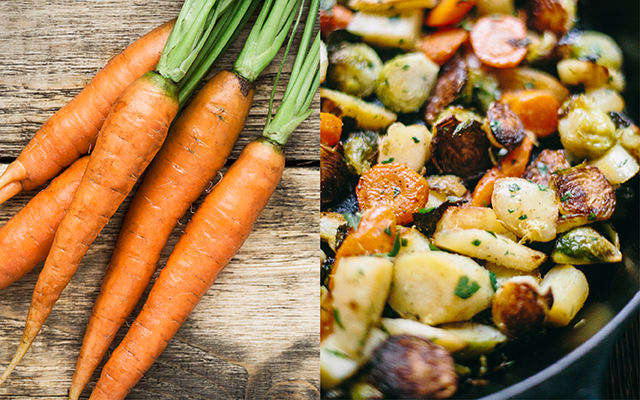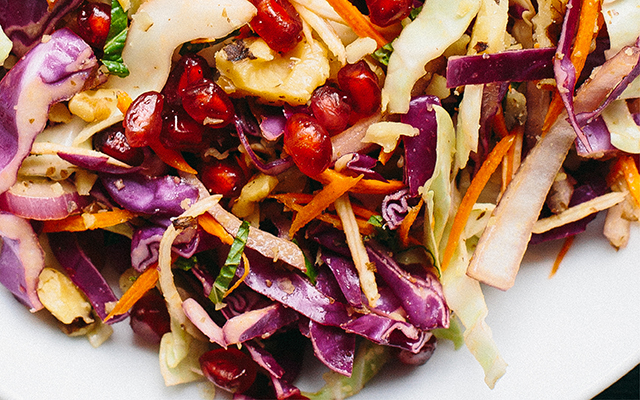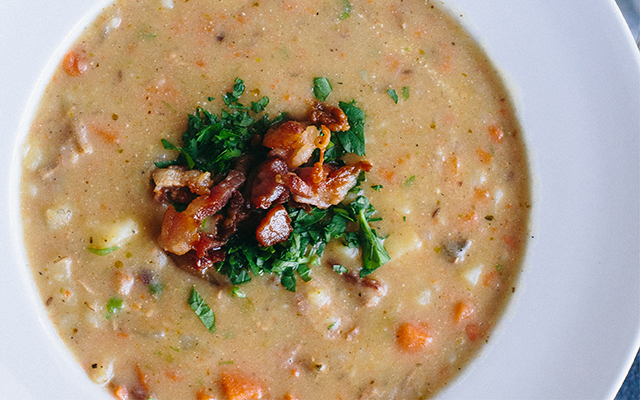I travel a great deal as a Russian translator for the U.S. Navy, a career that has given me fantastic opportunities to research many cultural and linguistic traditions. As someone who also manages an autoimmune disease, I’m fascinated by the intersection of food, ancestry, and personal health — and I’ve come to believe there’s no one-size-fits-all healthy diet.
My understanding is, in part, informed by the ancestry research and DNA testing I undertook for myself, which led me to the English villages where some of my distant relatives lived. After discovering my English heritage, I decided to start eating oats again — a food my ancestors would have eaten but which I avoided when I was following a strict paleo diet. In doing so, I feel I’m honoring not only my family heritage but my own health blueprint.
These days, I’m interested in recipes that have been passed down through generations within various cultural and ancestral traditions. Although many of my interpretations are paleo friendly, they also represent dishes that have withstood the test of time.
Recipes
Skillet-Roasted Winter Vegetables
Generations ago, people cooked meals on hearths and bread in ovens, and the two functions often happened in different parts of the house. Ovens and stoves eventually began to coexist in the kitchen, but roasting foods in an oven wasn’t common practice until relatively recently. Though we’ve been eating root vegetables for centuries, you could say roasting them is a new tradition.
 Photography by Russ Crandall
Photography by Russ CrandallMakes four servings
Prep time: 20 minutes
Cook time: 20 minutes
Ingredients
- 1/2 lb. carrots, peeled and cut into bite-sized chunks
- 1/2 lb. parsnips, peeled and cut into bite-sized chunks
- 3 tbs. duck fat, lard, or olive oil
- 1 lb. Brussels sprouts, sliced in half lengthwise, bottoms removed
- Zest of 1 lemon
- 2 tbs. chopped fresh parsley
- Salt and pepper to taste (about 1/4 tsp. each)
Directions
- Preheat the oven to 500 degrees F. Place the carrots and parsnips in a pot of salted water; bring to a boil, reduce heat to medium-high, and boil until they start to turn tender, about three minutes. (This is called parboiling and will help ensure the root vegetables finish roasting at the same time as the Brussels sprouts.) Drain and set aside.
- Place a seasoned cast-iron skillet in the oven until just smoking, about two minutes. (Heating the pan before adding the vegetables will speed up the cooking process.) Add the cooking fat, the Brussels sprouts, and the parboiled carrots and parsnips to the skillet; stir to combine.
- Roast until the vegetables are tender and crisp, about 20 minutes, stirring every five minutes. Remove from the oven, add the lemon zest, parsley, and salt and pepper to taste, and serve.
Tip: Feel free to swap out the carrots and parsnips for other root vegetables, like turnips or beets.
Winter Slaw
Russians consume more cabbage than those in any other country that counts its intake: about 40 pounds per person per year. By comparison, the average American eats only about 9 pounds annually. This dish is a fresh take on a traditional cabbage slaw that Eastern Europeans have enjoyed for centuries.
 Photography by Russ Crandall
Photography by Russ CrandallMakes six servings
Prep time: 20 minutes
Ingredients
- 1 1/2 heads green cabbage, shredded
- 1/2 head red cabbage, shredded
- 1/2 red onion, thinly sliced
- 2 carrots, thinly sliced into short strips
- 1 small handful fresh mint leaves, thinly sliced
- 1 tbs. Dijon mustard
- 1 tsp. apple-cider vinegar
- 1 tsp. olive oil
- Juice of 1/2 lemon (about 1 tbs.)
- 1/2 tsp. honey or coconut palm sugar
- 1/2 tsp. salt, or more to taste
- 1/2 cup chopped walnuts, divided
- 1 cup pomegranate seeds, divided
Directions
- In a large mixing bowl, add the cabbages, onion, carrots, and mint leaves. In a separate bowl, combine the mustard, vinegar, oil, lemon juice, honey, and salt.
- Pour the liquid into the cabbage mixture, and combine with your hands. Taste and add salt if needed. Mix in two-thirds of the walnuts and pomegranate seeds with your hands, and then scatter the remaining walnuts and pomegranate seeds on top. For best results, cover and refrigerate for at least an hour before serving.
Tip: Cabbage delivers vitamins C and K, sulfur, and folate. And the purple hue of the red variety signals bonus levels of inflammation-busting phytonutrients.
Buckwheat Kasha
Kasha” is a catch-all term meaning “porridge” in Russian, but the consistency of this dish is more like rice than oatmeal. If you can’t find roasted groats, roast them yourself in a dry pan over medium heat for five minutes, stirring occasionally.
 Photography by Russ Crandall
Photography by Russ CrandallMakes four servings
Prep time: five to 10 minutes
Cook time: 20 minutes
Ingredients
- 2 cups chicken or beef broth, or water
- 1 egg, lightly beaten
- 1 cup roasted, cracked buckwheat groats
- 2 tbs. butter
- Salt to taste
Directions
- In a saucepan, bring broth to a simmer over high heat; then reduce heat to low to keep broth warm.
- In a bowl, combine the beaten egg and roasted buckwheat; stir until buckwheat is evenly coated.
- Warm the butter in a skillet over medium-high heat. Add the buckwheat-egg mixture and toss until the buckwheat kernels are evenly coated with the butter. Sauté until the egg has dried and the kernels are separated, stirring constantly, about two minutes.
- Add broth to the skillet and bring to a simmer, stirring. Cover and reduce heat to medium-low; simmer until the liquid is absorbed, seven to 10 minutes. Salt to taste and serve immediately (try topping with butter or a fried egg). Refrigerate for up to three days.
Tip: Buckwheat is a gluten-free, whole-kernel grain that’s high in antioxidants and fiber.
Grilled Argentine Steak With Chimichurri
Cooks in Argentina perfected grilled meats long before Europeans introduced cattle there. A more authentic heritage-focused recipe would call for guinea pig — but that’s tough to find in a grocery store. This recipe uses cuts of grassfed beef such as tri-tip. The cilantro and rosemary give it a new twist.
 Photography by Russ Crandall
Photography by Russ CrandallMakes four to six servings
Prep time: 10 minutes, plus time to heat the grill
Cook time: 30 minutes, plus 10 minutes resting time
Ingredients
For the steak and marinade
- 1 tbs. kosher salt
- 1/2 tbs. black pepper
- 1/2 tbs. paprika
- 2 tbs. olive oil
- 2– to 4–lb. beef tri-tip or sirloin steak (look for 2– to 3–inch-thick cuts)
For the chimichurri
- 3 cloves garlic, minced
- 1 cup chopped fresh cilantro (about 3/4 bunch), stems included
- 1 tbs. chopped fresh oregano or rosemary leaves (from about 2 sprigs)
- 2 tbs. red-wine vinegar
- 1/3 cup olive oil, or more to taste
- Salt to taste
- 2 pinches black pepper
- 2 pinches crushed red-pepper flakes
- Lemon wedges
Directions
- Combine the marinade ingredients in a small bowl. Rub the marinade over the steak and set aside. Warm up the grill for indirect moderate heat: If using a charcoal grill, bank the coals to one side; if using a gas grill, ignite the burners on one side.
- Place the steak on the cool side of the grill and cook until it reaches an internal temperature of 110 degrees F, about 25 minutes. As the meat cooks, combine the chimichurri ingredients in a bowl.
- Move the steak to the hot side of the grill and cook on each side until lightly charred, about two minutes per side. (This technique of cooking first and searing second is called a reverse sear.)
- Remove steak from the grill and let it rest for 10 minutes before slicing against the grain. Serve with the chimichurri and lemon wedges.
Austrian Potato Soup
Erdapfel, or “earth apple,” is the term for “potato” in Switzerland, Austria, and southern Germany, while in northern Germany you say Kartoffel. Whatever you call them, potatoes deliver more potassium than bananas and a big dose of vitamin C. This classic soup is sure to satisfy on a cold winter day.
 Photography by Russ Crandall
Photography by Russ CrandallMakes six servings
Prep time: 15 minutes
Cook time: 45 minutes
Ingredients
- 1/2 oz. dried porcini mushrooms (about a handful)
- 1/2 lb. bacon ends and pieces, chopped
- 1 large onion, chopped
- 2 carrots, peeled and diced
- 3 stalks celery, diced (retain 1 tbs. chopped celery leaves)
- 1 bay leaf
- 1/2 tsp. marjoram (can substitute oregano)
- 1/2 tsp. caraway seeds
- 2 cups chicken broth
- 2 cups beef broth
- 2 1/2 lb. white potatoes, peeled, diced, and rinsed
- Salt and pepper to taste
- 2 tbs. sour cream (can substitute coconut milk)
- 1 handful fresh parsley, chopped
Directions
- Place the mushrooms in a small bowl and cover with warm water; set aside to reconstitute, about 15 minutes. While the mushrooms soak, warm a stockpot over medium-low heat, then add the bacon and sauté until crispy, about 10 minutes. With a slotted spoon, remove the bacon pieces and set aside.
- Increase the heat under the stockpot to medium, and add the onion to the bacon grease; sauté until softened, about five minutes. Add the carrot and celery, and sauté until bright in color, about two minutes. Add the chopped celery leaves, bay leaf, marjoram, caraway seeds, chicken broth, and beef broth.
- Remove the mushrooms from their liquid and coarsely chop, and then add them to the soup; strain the liquid you soaked the mushrooms in and add it to the soup as well.
- Bring the soup to a boil, and then reduce the heat to low and simmer until the carrots are tender, about eight minutes. Add the diced potatoes; if needed, add water to ensure the potatoes are covered by liquid. Return to a boil over medium-high heat, and then reduce the heat and simmer on low until the potatoes are very tender, about 15 minutes.
- Using a potato masher or an immersion blender, partially mash or blend the soup until smooth (with a blender, this should take just a few pulses). Add salt and pepper to taste. Remove soup from heat and stir in the sour cream, reserved bacon, and parsley. Serve warm.
Why No Numbers? Readers sometimes ask us why we don’t publish nutrition information with our recipes. We believe that (barring specific medical advice to the contrary) if you’re eating primarily whole, healthy foods — an array of sustainably raised vegetables, fruits, nuts, seeds, legumes, meats, fish, eggs, whole-kernel grains, and healthy fats and oils — you probably don’t need to stress about the numbers. We prefer to focus on food quality and trust our bodies to tell us what we need. — The Editors
This originally appeared as “Hearty Traditions” in the December 2017 issue of Experience Life.


This Post Has 0 Comments